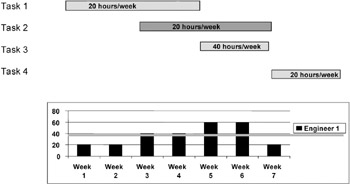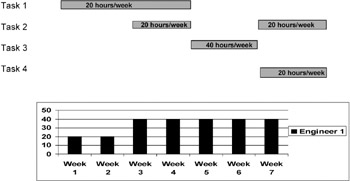What is a resource histogram?
|
A resource histogram is one of the tools given to us by the companies that produce project management software to help the allocation of resources in project plans. Automatic resource leveling does not usually give us the best solution to a resource allocation problem. Until we have good artificial intelligence programs to help us, automatic resource leveling will probably give us very long schedules.
The resource histogram allows us to look at the individual resources in a schedule and the Gantt chart at the same time. By looking at these two displays simultaneously, we can make intelligent decisions regarding the use of the resources. The resource histogram shows the amount of use and availability for the resource, and the Gantt chart shows the activities that the resource is scheduled to be working on.
Tell me more …
When project schedules moved from the hands of the draftsmen who were drawing activity on arrow diagrams and Gantt charts by hand to computers, it became much faster to produce results. Unfortunately, many of these results created difficulties. Prior to computerization, resource allocation was difficult to do efficiently. When computerization began and automatic resource leveling was introduced, it was considered a great step forward. It did not take people long to realize that the computerized resource leveling was not terribly intelligent.
The resource leveling algorithm used by most computer software packages examines the project schedule until a conflict arises. A resource conflict occurs when two or more activities require the use of a resource that has less availability than the resources require. Let us say that we have a five-day activity that starts on Tuesday, January 5, and is scheduled to end on Monday, January 11 (no work on weekends), and an eightday activity that starts on January 7 and is scheduled to finish on January 18. Let us also say that the two activities require the full-time effort of Mary Engineer.
This is a resource conflict; both of the scheduled activities require the resource on January 7, 8, and 11. In this situation the computer's resource-leveling algorithm would schedule the first activity to start on January 5 and reschedule the second activity to start on January 12 when the resource becomes available. This is only one of many possible solutions to the resource conflict, and it may not always be the best solution. There is no consideration for use of total float and free float, length of activity duration, risk, or the number of other activities that depend on the one being rescheduled. In other words it is pretty simple-minded.
Referring to Figure 5-14, we have another example of a resource conflict. Here we will use the resource histogram to help us solve the problem. In weeks one and two the resource, "Engineer 1" is not being fully utilized. "Engineer 1" is used for only twenty hours per week. Task 1 is the only task using our engineer.

Figure 5-14: RESOURCE HISTOGRAM WITH GANTT CHART
During weeks three and four we continue working on task one and also work on task two. Since both of these tasks require our engineer to work twenty hours per week, we can schedule the engineer to work parttime on each of the tasks. This means that she will be used forty hours per week.
Now comes the problem. In week 5 and 6 the project schedule calls for task three to start and for task one to end. The trouble is that task three requires our engineer to work for forty hours on that task alone. If we try to complete the work on task two and start working on task three, we will require sixty hours per week of the engineer's time. Asking our engineer to work twenty hours of overtime may have mixed results from the engineer and her family. We also notice that after week six is completed, we have only twenty hours of work for our engineer again.
There are many ways that this problem could be solved. We could delay the start of task three until task two is completed. We could reschedule task two to start after task three was completed.
In the solution shown in Figure 5-15, we have chosen to interrupt task two after it has been worked on for two weeks. At this point in the schedule the engineer starts work on task 3 and continues working on it until it is completed. When task three is finished, she starts work on task 4 and continues work on task two. Notice that this solution makes the utilization of our engineer much better. The engineer is now scheduled to be working forty hours each week during weeks 3, 4, 5, 6, and 7.

Figure 5-15: OVERALLOCATION OF RESOURCE RESOLVED
Using the resource histogram is quite easy. Most software allows you to easily see the scheduled tasks with simple mouse points and clicks. The resource histogram will change to reflect the changes made in the schedule, which makes it relatively easy to make an optimum schedule using real people. Although only one resource can be shown at a time, you can scroll through the resources quickly. The Gantt chart can be made to filter out the tasks that do not use the resource.
|
EAN: 2147483647
Pages: 126
- The Effects of an Enterprise Resource Planning System (ERP) Implementation on Job Characteristics – A Study using the Hackman and Oldham Job Characteristics Model
- Data Mining for Business Process Reengineering
- Intrinsic and Contextual Data Quality: The Effect of Media and Personal Involvement
- Relevance and Micro-Relevance for the Professional as Determinants of IT-Diffusion and IT-Use in Healthcare
- Development of Interactive Web Sites to Enhance Police/Community Relations